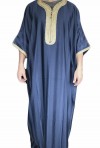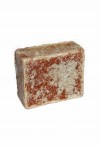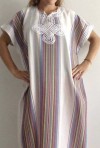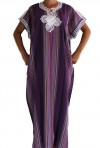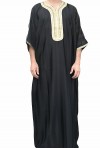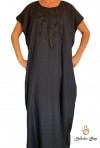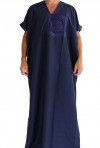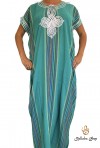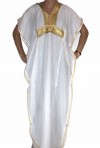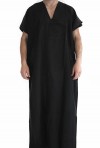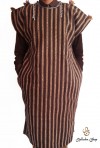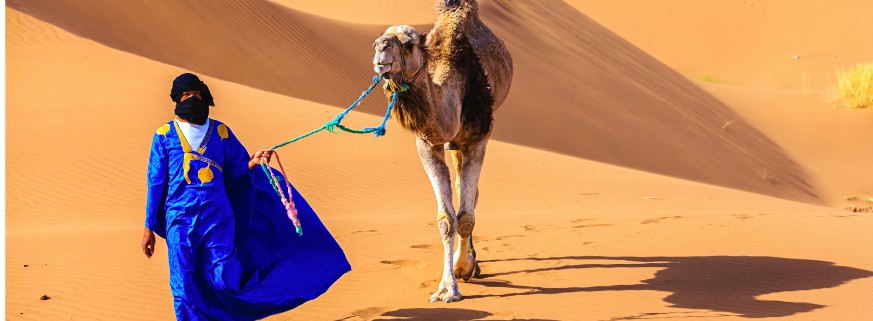
Djellaba marocaine homme
The origin of the word djellaba and the first Moroccans to wear it
The term djellaba was not common except in Morocco and Andalusia. Its origin is believed to come from the Arabic word "jilbab" as mentioned by Ibn Manzur in Lisan al-Arab. And the word galabiya in Morocco meant nothing but a special garment for men, which is the specialty of general and poor groups, and it appeals to people and professionals for night watchmen and men .
The first indication that the jilbab was a special garment for the righteous is what was mentioned by the author of the book "Doha Al-Nasher" in his translation of one of the righteous from the city of Tetouan at the beginning of the century AD , and it was the time of the free lady; "Abu Abdullah Muhammad Al-Bahja Al-Andalusi, one of the companions of Sheikh Abi Al-Hassan, used to buy for him - that is, for the righteous man - a beret, a galabiya and a shawl." The reference to the djellaba was also mentioned by the author of the book "Al-Rawd Al-Atr Al-Nafas" in his translation of one of the righteous men of Fez. This is Sidi Azzouz .
Wearing a djeelaba man was not limited to virtuous Moroccans alone; On the contrary, it was also the clothes of the poor. Whereas Frenchman Moyet, who spent eleven years in captivity during the time of Sultan Mawla Ismail Al-Alawi; He called this djellaba the djellaba of the poor; Where he says in his memoirs, which he wrote after his return to France: “Our costume consisted of a woolen djellaba with a headgear and an ambush, like the habit of a monk; And it was suitable as a hat. » . As for the dress of the rich, scholars and notables, it was different.
As Leo the African (Hassan al-Wazzan), who visited the city of Fez in the middle of the 16th century, describes it, saying: “And the people of Fez, I mean the notables among them, are really respectable people; In winter, they wear woolen cloths imported from abroad. It consists of a very narrow tunic with half sleeves (indicating in our perception of heresy); They put on a shirt and over it a large cloak sewn in front, and they cover all this with a veil (silham).
Moroccan djellaba
It is customary for scholars and notables of advanced age to wear tunics with wide sleeves, such as those worn by the nobles of Venice . Al-Hassan bin Muhammad Al-Wazzan did not neglect to refer to the clothing of the poor and the general population of Morocco in the 16th century AD when he said: They wore a coarse woolen garment of the country and their djellaba (Al- Silham) were made of the same fabric.
And if we want a closer look at how special people dress up; for that demands a return to the dress of sultans; Especially the sultans of the Marinid and Saadian states; References to how they dress have been mentioned in historical references. If the sultans of Bani Marin and the Wattasids had kept some of the formal costumes that prevailed in the Almohad period; like a turban and a prince; Ihram and Jubbah were added to it. but in white; State emblem .
The Saadis, who reigned over Morocco from the middle of the 16th century, did not go beyond their attire at the beginning of their entry into the ax of armor and clothing . But then they will benefit from the clothing traditions of Maribin; On the contrary, the Turkish djellaba will become the official djellaba of their kings, especially during the time of Abd al-Malik and Ahmed al-Mansur al-Dhahabi. It was the djellaba that continued as part of the traditions of the Alawite sultans during the time of Mawla al-Rashid and Mawla Ismail .
When did the Moroccan djellaba become a garment for kings and sultans?
No one can provide a satisfactory answer in the absence of historical references that can provide a precise date; The only exception we could support; This is the book "Pride and Prejudice", which chronicles the period of the reign of Sultan Abd al-Rahman bin Hisham al-Alawi. These are the beginnings that coincided with the second decade of the 19th century; Where this sultan will succeed the king after the death of his uncle, Sultan Mawla Suleiman in 1822 AD.
The Alaouite state historian, Abd al-Rahman bin Zaidan, describes in his book "The Glory and Power" of the sultan's djellaba, saying: "And if he entered the palace, he wore what we presented, a hood without a turban, and his usual clothes are trousers and a caftan shirt from the backrest, or what looks like it according to the time of the time, a chastity and a djellaba of the national fabric; As for the two sultans, Mawla al-Rasheed and the Ismail state, they imitated the kings of the Saadian state” .
As to why the jilbab became part of the sultan's attire, no one can give a satisfactory answer. Apart from certain hypotheses which accept confirmation or negation; And among them, in our opinion: is the distinction between the sultan and those in his service, and what is meant by this is the consultation of the palace. Especially since the clothing of these people until today consists of the caftan and above it is the vagina or al-Mansuriya (relating to al-Mansur al-Dhahabi), then the salham or prince without the djellabas, which is the royal djellaba that was worn by Sultan Ahmed al-Mansur al-Dhahabi.
It became part of the dress of the royal court. Furthermore, the association of the Djellabas with the righteous and the general public; It will make the sultan not hesitate to wear it, especially if we consider the biography of sultans who were distinguished by asceticism and closeness to the people, such as the two sultans, Mawla Suleiman and his nephew, the sultan Abd al-Rahman bin Hisham, the latter who did not hesitate to wear patchwork clothes, as we have seen, according to what the historian Abd Rahman reported And he wore patchwork trousers to one of his legs as he was about to enter the capital Ismaïlia (the city of Meknes)
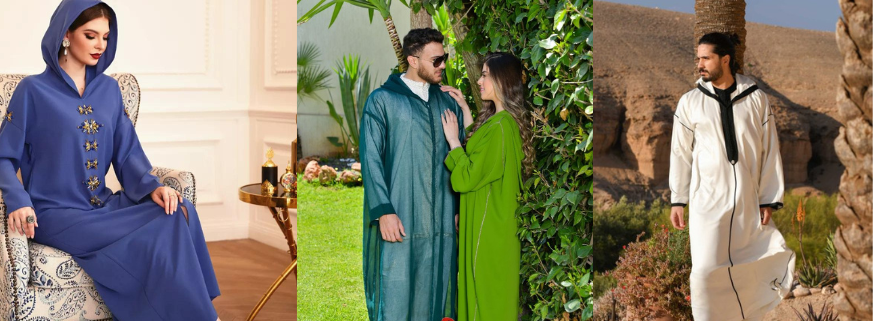
The diffusion of the djellaba among Moroccan elites and Moroccans in general
The elites of Moroccan society at the end of the 19th century, as Wester Mark evoked in his book "The Ceremonies of Marriage in Morocco" (published at the beginning of the 20th century), took the jilbab as a garment, abandoning the circumference ( a djellaba that envelops the djellaba) by circumference, as people follow the religion of their kings. And the author of the same book confirms that at that time the djellaba appears as a particular garment inside the palaces of the Makhzen, but it gradually leaves its walls and spreads among the middle classes and the vast majority of population.
As for the clues that the jilbab has become a warehouse garment; Mawla Abd al-Rahman bin Hisham Abd al-Qadir Ashshaa's ambassador wore what the French considered the national dress, as they gave an accurate description of this ambassador who was assigned to an important embassy in Paris between the years 1845 and 1846.
And what emerged from this French description of this Moroccan ambassador: that the latter "wears a pointed fez at the end. He is surrounded by a turban in fine Mosulian djellaba, and his head is surrounded by a red cashmere djellaba. On several short shirts, he wears a loose djellaba called the djellaba, which is the national dress in Morocco" .
The emergence of women's djellaba
As for women wearing djellaba, the women of Fez, at the beginning of the 20th century, tried to anticipate the wheel of time, by adopting djellabas as clothing, which will incite the elites of the city of Fez to confront the question with all severity and severity. In order to prove this incident, it was necessary to refer to transfers as an important historical source, especially since the history books do not help us in this, which are transfers that were supposed to document the endowments of the cities and what is retained on the mosques, A documentation dating from 10 Safar 1323 is mentioned in the transfer of the villagers.
And this documented testimony, which is subject to all the conditions of documentation, was proof of the great and fierce resistance with which the Fassi patriarchal community faced its women who tried to dress in a djellaba which until recently was a pure royal djellaba. And if they succeeded, as one of the French women would describe it, the women of Fez as they wear djellaba woman at one of the city's weddings, after these women of the
beginning of the 20th century, especially the nobles, bundled themselves up in a long piece of white cloth (Hayek) which completely concealed their forms, and they had to wear a thick white veil which left their eyes uncovered, as mentioned in the book “Fez before protection” by Roggi Loturno .
Thus, Moroccan djellabas have evolved over the years from male clothing to become common to both men and women, after women abandoned the wearing of the scarf. It also evolved in its shape, as it was initially wide and baggy for men, then gradually moved closer to the body without touching it or defining its features. Over the years, it evolved in its details and tailoring until it became standardized in its currently known image, and it became, along with the prince and the balghah, the national dress of Moroccans . traditions in force on official occasions; Especially during the opening of Parliament.
The origin of the word djellaba and the first Moroccans to wear it The term djellaba was not common except in Morocco and Andalusia. Its origin is believed to come from the Arabic word "jilbab" as mentioned by Ibn Manzur in Lisan al-Arab.

